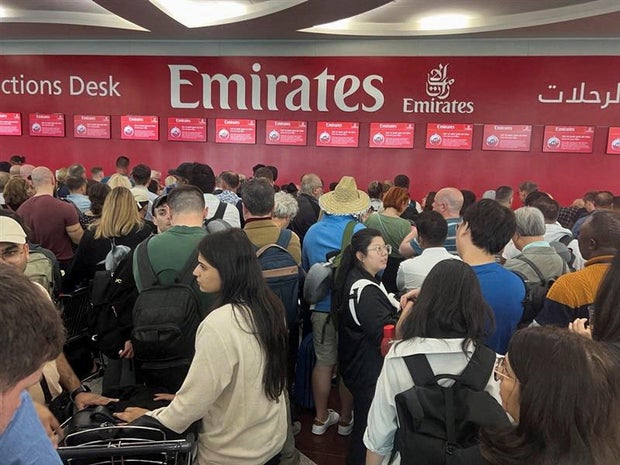Dubai, United Arab Emirates — The UAE fought on Thursday to recover from the heaviest rains recorded that ever hit the desert nation as its main airport worked to restore normal operations, even as floodwaters still covered parts of major highways and roads.
Dubai International Airport, the world’s busiest for international travel, allowed global airlines to once again fly into the airfield’s Terminal 1 on Thursday morning. Later on Thursday, the facility said in a message posted on social media that its Terminal 3 was also reopening for flight check-in, but warned passengers to only come if their pending departure was confirmed due to “a large volume of guests at check-in.” -in the area.”
“Flights continue to be delayed and disrupted, so we ask that you only come to Terminal 1 if you have a confirmed reservation,” the airport said in its statement. series of tweets.
Later on Thursday, a message shared by the Dubai government’s media office quoted Dubai International Airport chief operating officer Majed Al Joker as saying the facility would “return to full operational capacity within 24 hours.”
Rula Rouhana/REUTERS
Long-haul carrier Emirates, whose operations had struggled since Tuesday’s storm, prevented travelers leaving the United Arab Emirates from checking in to their flights as it tried to pick up connecting passengers. Pilots and flight crews struggled to reach the airport due to water on the roads. But on Thursday, they lifted the order to allow customers into the airport.
Others arriving at the airport described hours-long waits to collect their luggage, and some simply gave up on going home or to any hotel that would accept them.
The United Arab Emirates, an autocratic, hereditarily-ruled nation on the Arabian Peninsula, typically sees little rainfall in its arid desert climate. However, a huge storm that meteorologists had been warning about for days hit the country’s seven sheikhdoms. By late Tuesday, more than 5.59 inches of rain drenched Dubai in 24 hours. On average, a year sees 3.73 inches of rain at Dubai International Airport. Other areas of the country recorded even more precipitation.
The UAE’s drainage systems quickly became overwhelmed, flooding neighborhoods, commercial districts and even parts of the 12-lane Sheikh Zayed Road highway that runs through Dubai.
State news agency WAM called the rain “a historic weather event” that surpassed “everything that has been documented since data collection began in 1949.”
In a message to the nation on Wednesday, Emirati leader Sheikh Mohammed bin Zayed Al Nahyan, ruler of Abu Dhabi, said authorities would “work quickly on studying infrastructure conditions across the UAE and to limit the damage caused.”
On Thursday, people waded through oil-stained floodwaters to get to previously abandoned cars, checking to see if their engines were still running. Tanker trucks with vacuum cleaners have also started arriving for the first time in some areas outside central Dubai. Schools remain closed until next week.
Jon Gambrel/AP
Authorities did not provide general information about damage or injuries caused by the floods, which killed at least one person.
“Crises reveal the strength of countries and societies,” wrote the ruler of Dubai, Sheikh Mohammed bin Rashid Al Maktoum, in X. “The natural climate crisis we are experiencing has shown the great care, awareness, cohesion and love for every corner of the world. country, from all its citizens and residents.”
The floods have sparked speculation that the UAE’s aggressive policy cloud seeding campaign – fly small planes through clouds dispersing chemicals with the aim of making it rain – may have contributed to the flood. But experts say the storm systems that produced the rain were predicted well in advance and that cloud formation alone would not have caused such flooding.
Jeff Masters, a meteorologist at Yale Climate Connections, said the flooding in Dubai was caused by an unusually strong low pressure system that spawned many series of strong storms.
Climatologists have warned for years that human action of Climate Change is supplying more extreme and less predictable weather events around the world.
Parts of southern Russia and Central Asia have also been experiencing unusually damaging amounts of rain and snowmelt for days, forcing tens of thousands of people to evacuate to higher ground and killing more than 120 people in Pakistan and Afghanistan.
Dubai hosted the United Nations COP28 climate talks just last year.
Abu Dhabi’s state-run newspaper The National, in an editorial on Thursday, described the heavy rains as a warning to countries in the wider Persian Gulf region to “prepare their futures for climate change”.
“The scale of this task is more daunting than it first appears, because such changes involve changing the urban environment of a region that, since it was first inhabited, has experienced little other than heat and sand,” the paper said. .

























